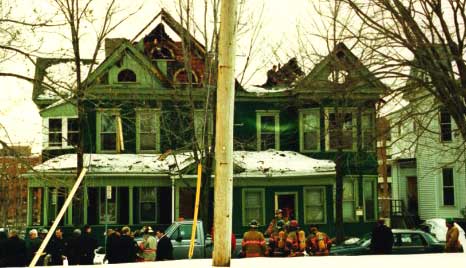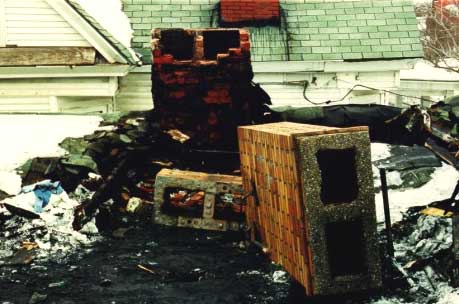

Fire Investigator Dies After Being Struck by a Chimney That Collapsed During an Origin and Cause Fire Investigation - New York
SUMMARY
On January 19, 1999, a 43-year-old male career fire investigator (the victim) was killed during an investigation to determine the origin and cause of a residential fire that occurred on January 14, 1999. The victim, as part of his regular duties, met with an insurance adjuster, a private fire investigator and an electrical consultant at the fire scene about 1030 hours on the day of the incident. All four men proceeded to the attic area of the remaining structure to conduct the investigation. About 10 minutes into the investigation, the insurance adjuster left the area and proceeded to the floors below to continue his review of the damage. The other three men, including the victim, remained in the attic and sifted through debris looking for clues to the origin of the fire. After working for 2½ hours near the front section of the attic, they moved to an area in proximity to a brick chimney that was free-standing about 13 feet above the floor level of the attic. After discussing the stability of the chimney, the three men decided to continue work near the chimney. Note: Although all three men commented to one another that they had seen the chimney swaying slightly in the gusty breeze, they believed it was fairly stable because it had been free-standing for 5 days, in all weather conditions. Also, the chimney had not moved when the private investigator pushed and pulled on the stabilizing bar that was connected to it. The victim had positioned himself about 8 feet away and directly in line with the base of the chimney while the other investigators, although also in proximity to the chimney, were off to one side. The three men were sifting through and inspecting the debris when the chimney suddenly and silently collapsed and fell onto the victim. The sound of the chimney hitting the floor alerted the other two men. After realizing what had occurred, they tried to lift the chimney off the victim, but it was too heavy. One of the men ran to a neighboring house and called 911. At this time another fire investigator arrived on the scene and was apprised of the situation. He used his fire radio to call for a rescue company. Within a few minutes, two fire Chiefs arrived on the scene and the five men were able to lift the chimney off the victim. Emergency cardiopulmonary resuscitation was initiated and the victim was transported to the local hospital where he later died of his injuries. NIOSH investigators concluded that, to minimize the risk of similar occurrences, fire departments should:
INTRODUCTION
On January 19, 1999, a 43-year-old male career fire investigator (the victim) died after being crushed by a chimney that collapsed. On January 22, 1999, the U.S. Fire Administration notified NIOSH of the incident, and on February 24, 1999, a Safety and Occupational Health Specialist from NIOSH investigated the incident. The incident was reviewed with the Chief, Safety Officer and Fire Investigator from the Fire Department. Photographs of the incident site were obtained and the medical examiner’s report was requested.
The fire department involved in the incident serves a population of 160,000 in a geographic area of 25 square miles and is comprised of 378 uniformed personnel. Fire fighter training is required by the State and includes 229 hours of basic recruit training. The training is designed to cover personal safety, forcible entry, ventilation, fire apparatus, ladders, self-contained breathing apparatus, hose loads, streams, hazardous materials, structure fire, pumps, rappeling, search and rescue, terrorism, vehicle extraction, cardiopulmonary resuscitation, first aid, aerial operations, and electrical emergencies. The victim had 20 years of fire fighting experience which included 5½ years as a fire investigator. Also, the victim had completed a building construction course for the fire service in December 1998. This course was college accredited and involved structural integrity and building collapse.
INVESTIGATION
On January 14, 1999, a fire at a residence more than 80 years old and containing three apartments was reported to the city fire department (see Figure 1). The fire department responded and extinguished the fire within 1 hour by performing an exterior attack with deck guns. After salvage operations were completed the fire companies returned to their departments. It was determined that the investigation to determine the fire’s origin and cause would be delayed until weather conditions improved from the sub-zero temperatures of the day of the fire. Five days after the fire, weather conditions had improved and an origin-and-cause investigation was scheduled for January 19, 1999. About 1030 hours on the day of the incident, a fire investigator from the department met with an insurance adjuster, a private fire investigator and an electrical consultant at the fire scene to conduct the investigation. All four men proceeded to the attic area where the investigation commenced. About 10 minutes into the investigation, the insurance adjuster left the area and proceeded to the floors below to continue his investigation. The three other men, including the victim, remained in the attic and sifted through debris for clues to the origin of the fire. About 2½ hours later, they had moved to an area near a brick chimney that was free-standing about 13 feet above the floor level of the attic. The section of the free-standing chimney above the roof line appeared to have been an add-on to the original chimney, as two different types of brick were present from below and above the roof line to the top of the chimney. The chimney had been constructed of single bricks and mortar stacked together, and the chimney contained no internal liner/flue (see Figure 2.). The dimensions of the section of chimney which collapsed were 98 inches high by 38 inches wide by 17 inches deep, and its estimated weight was between 2,500 - 3,000 lbs. The chimney had been free-standing for 5 days and had been subjected to direct fire exposure, freezing and thawing temperatures (-7o to 44o F), water loading from deck guns, and wind gusts to 56 m.p.h. Note: About the time of the incident, wind was constant from the west and at a 90o angle to the chimney, between 33 - 36 m.p.h.
After discussing the stability of the chimney the three men decided to continue work near it even though they had seen it swaying in the wind. Although working within 15 feet of one another, the three men were positioned at different locations in relation to the chimney. Two of the investigators were off to one side of the chimney, while the victim was located about 8 feet directly in line with the base of the chimney. The three men were sifting through and inspecting the debris when the chimney suddenly and silently collapsed and fell onto the victim. The sound of the chimney hitting the floor alerted the two other men, and after realizing what had occurred, they tried to lift the chimney off the victim, but it was too heavy. One of the men ran to a neighboring house and called 911. At this time another fire investigator arrived on the scene and was apprised of the situation. He used his fire radio to call for a rescue company. Hearing the call, two fire Chiefs arrived on the scene within a few minutes and the five men were able to lift the chimney off the victim. Emergency cardiopulmonary resuscitation was initiated and the victim was transported to the local hospital where he later died of his injuries.
CAUSE OF DEATH
The medical examiner reported the cause of death as multiple injuries as a result of falling debris.
RECOMMENDATIONS/DISCUSSION
Recommendation #1: Fire department personnel should conduct an assessment of the stability and safety of the structure, e.g., roofs, ceilings, partitions, load-bearing walls, floors, and chimneys, before entering damaged, e.g., by fire or water, structures for the purpose of investigations.
Discussion: Due to the destructive powers of fire, most structures that have been involved in fires or explosions are structurally weakened. Analysis of the exterior of the structure should be done continuously while conducting exterior scene investigations. Similarly, before the interior examination is conducted, the structure should be determined safe to work in by conferring with the Incident Commander or requesting an inspection from building and safety. If necessary, the investigator should seek the help of qualified structural experts to assess the need for the removal of dangerously weakened construction or should make provisions for shoring up load-bearing walls, floors, ceilings, roofs, or as in this case, a chimney. In this case, had a thorough assessment been made of the structure, including the chimney, the origin-and-cause investigation could have been postponed until the area around the chimney had been roped off and a collapse zone established, or the chimney had been demolished or stabilized.1,2
REFERENCES
1) NFPA 921: Guide for fire and explosion investigations. 1998 ed. Quincy, MA: National Fire Protection Association.
2) FEMA [1994]. Fire/arson investigation. Emmitsburg, MD: Federal Emergency Management Agency, United States Fire Administration, National Fire Academy, Publication No. FEMA/USFA/NFA-F/AI-SM.
INVESTIGATOR INFORMATION
Richard W. Braddee, Safety and Occupational Health Specialist, Surveillance and Field Investigations Branch, Division of Safety Research.

Figure 1. Fire Scene

Figure 2. Collapsed Brick Chimney
Return to Fire Fighter Homepage
This page was last updated on 11/21/05